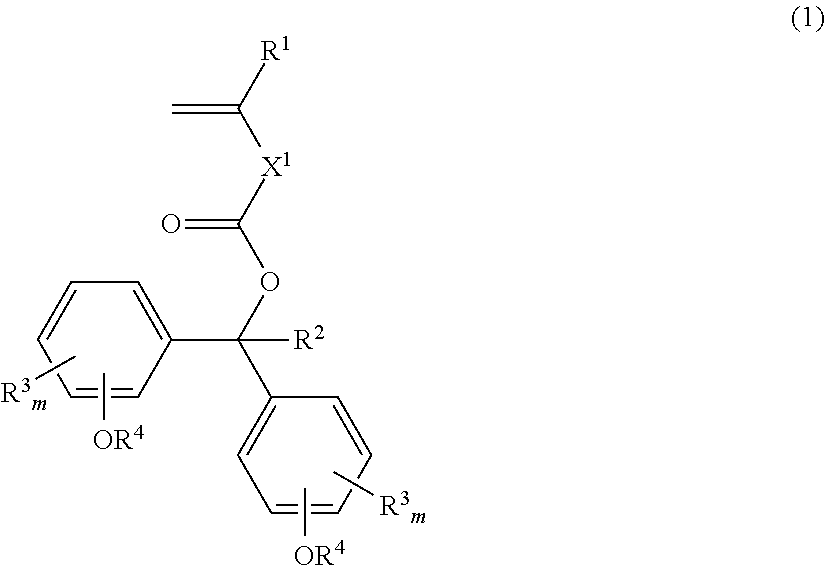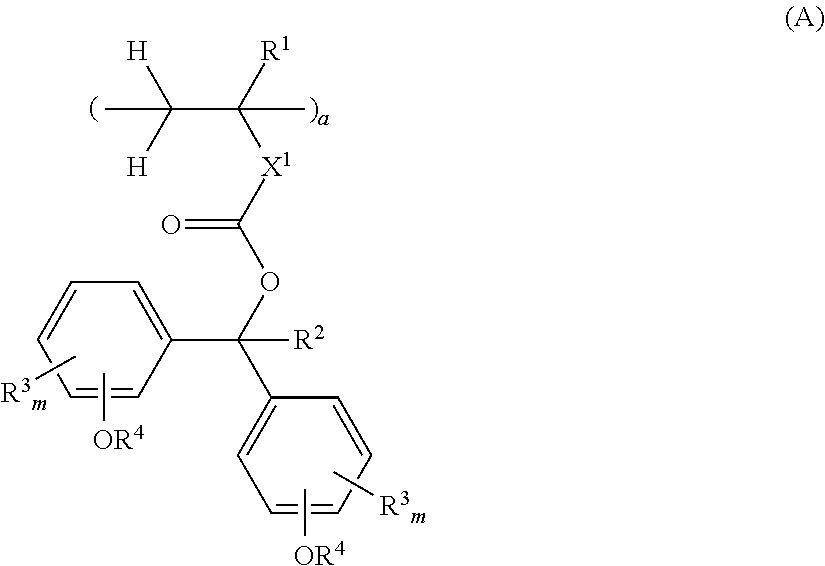Monomer, polymer, positive resist composition, and patterning process
a polymer and resist composition technology, applied in the field of monomer, polymer, positive resist composition, and patterning process, can solve the problems of insufficient dissolution contrast of resist composition containing a polymer comprising recurring units derived from hydroxyphenyl methacrylate protected with an acid labile group, and achieve high alkaline dissolution rate contrast, improve profile, and high resolution
- Summary
- Abstract
- Description
- Claims
- Application Information
AI Technical Summary
Benefits of technology
Problems solved by technology
Method used
Image
Examples
example 1-1
[0212]
example 1-1-1
Synthesis of Alcohol 1
[0213]In nitrogen atmosphere, a solution of Chloride 1 (203.1 g) and 1,2-dibromoethane (1.2 g) in THF (183 g) was added dropwise to a suspension of magnesium (28.1 g) in THF (30 g) at a temperature of 65-80° C. Stirring was continued at the temperature for 12 hours, obtaining Grignard reagent 1. The reaction solution was cooled to room temperature, to which a solution of ethyl formate (37.0 g) in THF (240 g) was added dropwise at a temperature of 20-40° C. Stirring was continued at the temperature for 3 hours. A 15 wt % ammonium chloride aqueous solution (1,300 g) was added dropwise to the reaction solution to quench the reaction. This was followed by ordinary aqueous workup and recrystallization from an ethyl acetate / n-hexane mixture, obtaining Alcohol 1 (138 g, yield 84%). It was analyzed by 1H-NMR spectroscopy.
[0214]1H-NMR (600 MHz in DMSO-d6):
[0215]δ=7.24 (4H, d), 6.89 (4H, d), 5.73 (1H, d), 5.61 (1H, d), 1.24 (18H, s) ppm
example 1-1-2
Synthesis of Monomer 1
[0216]Alcohol 1 (137 g), triethylamine (59.4 g) and 4-(dimethylamino)pyridine (1.5 g) were added to toluene (200 g). To the solution which was heated at an internal temperature of 40-50° C., Esterifying agent 1 (74.3 g) was added dropwise. The solution was stirred at 50° C. for 2 hours. The reaction solution was ice cooled, to which a saturated sodium hydrogencarbonate aqueous solution was added dropwise to quench the reaction. This was followed by ordinary aqueous workup and recrystallization from an ethyl acetate / methanol mixture, obtaining Monomer 1 (146 g, yield 87%). It was analyzed by IR and 1H-NMR spectroscopy.
[0217]IR (D-ATR); ν=2976, 2930, 1709, 1637, 1605, 1505, 1365, 1290, 1238, 1174, 1157, 1107, 1014, 897, 859 cm−1
[0218]1H-NMR (600 MHz in DMSO-d6):
[0219]δ−7.28 (4H, d), 6.93 (4H, d), 6.80 (1H, s), 6.17 (1H, s), 5.71 (1H, m), 1.92 (3H, s), 1.26 (18H, s) ppm
PUM
| Property | Measurement | Unit |
|---|---|---|
| size | aaaaa | aaaaa |
| temperature | aaaaa | aaaaa |
| temperature | aaaaa | aaaaa |
Abstract
Description
Claims
Application Information
 Login to View More
Login to View More - R&D
- Intellectual Property
- Life Sciences
- Materials
- Tech Scout
- Unparalleled Data Quality
- Higher Quality Content
- 60% Fewer Hallucinations
Browse by: Latest US Patents, China's latest patents, Technical Efficacy Thesaurus, Application Domain, Technology Topic, Popular Technical Reports.
© 2025 PatSnap. All rights reserved.Legal|Privacy policy|Modern Slavery Act Transparency Statement|Sitemap|About US| Contact US: help@patsnap.com



